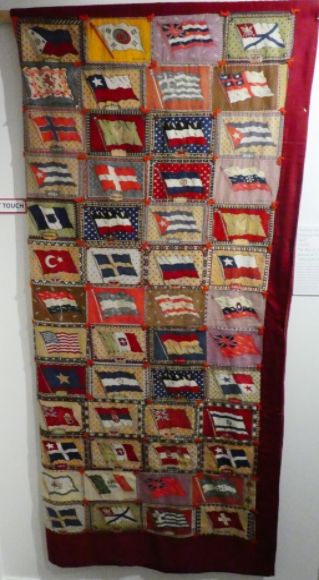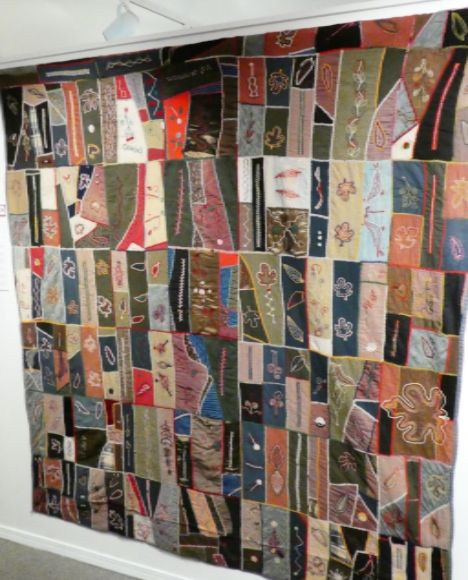Necessity and Beauty is a display of quilts from the permanent collection of the History Museum at Fort Missoula in Missoula, Montana.
According to the display:
“Initially overlooked as merely utilitarian women’s work and dismissed by the fine arts world as unworthy of consideration, quilting has in recent decades risen in esteem and now admired as objects of aesthetic beauty.”

 Shown above is an Ocean Waves Pattern made in 1885 by Sarah Emma Akard Hawk.
Shown above is an Ocean Waves Pattern made in 1885 by Sarah Emma Akard Hawk.
According to the display:
“The Ocean Waves pattern features pieced triangle waves that cascade across the quilt, especially when the blocks are set on point creating interlocking X’s or a lattice look. The pattern is a ‘quilt of illusion’ as it creates an optical illusion making it difficult to see the pattern and determine where one block ends and another begins.”

 Shown above is a crazy quilt made about 1900.
Shown above is a crazy quilt made about 1900.
 Shown above is a tobacco fabric novelties quilt from the 1920s.
Shown above is a tobacco fabric novelties quilt from the 1920s.
According to the display:
“In the early 1900’s, to encourage sales, American tobacco companies inserted collectable novelty items into tobacco products. The novelties included a variety of textiles, with flannel flags of nations an especially popular subject. Quilters incorporated the collectible flags into their designs, with this style presenting a variety of national flags the most popular approach.”
 Shown above is a four-patch quilt made about 1920.
Shown above is a four-patch quilt made about 1920.
 Shown above is an undated Barn Raising Log Cabin quilt. It is called a Barn Raising variation due to its blocks divided by color diagonally to form concentric diamonds.
Shown above is an undated Barn Raising Log Cabin quilt. It is called a Barn Raising variation due to its blocks divided by color diagonally to form concentric diamonds.
According to the display:
“The Log Cabin quilt design dates from Abraham Lincoln’s 1860 “Log Cabin” campaign. This style introduced a new method of quilt-making calling for individual pieces of fabric, the logs of the cabin, to be sewn to an underlying piece of fabric as well as to each other.”
 Shown above is a Crib Quilt Top with a Tumbling Blocks Pattern made about 1890.
Shown above is a Crib Quilt Top with a Tumbling Blocks Pattern made about 1890.
 Shown above is a Soogan Quilt made about 1930 by an unknown quilt maker.
Shown above is a Soogan Quilt made about 1930 by an unknown quilt maker.
According to the display:
“Stark, utilitarian, and of basic design, this wool Soogan exemplifies a unique Montanan and Western quilt style. A Soogan is a tied, patchwork, down filled quilt, wrapped in a waterproof canvas cover, used by cowboys as a bedroll. The word is derived from an old Irish word denoting a type of straw rope. Soogans are quite bulky, too large to be tied behind the saddle, requiring the cowboy to load the quilt into the chuck wagon or on some other wagon for transport between camps.”
 Shown above is Generations made in 1950.
Shown above is Generations made in 1950.
 Shown above is a Crazy Quilt made in 1895 by Nancy Jane Hise.
Shown above is a Crazy Quilt made in 1895 by Nancy Jane Hise.
 Shown above is a Flower Basket quilt made about 1920 by an unknown quiltmaker.
Shown above is a Flower Basket quilt made about 1920 by an unknown quiltmaker.
 Shown above is a Double Wedding Ring quilt made about 1930 by Elizabeth Connacher. This was a popular pattern in the 1930s and was used to showcase quilt making skills.
Shown above is a Double Wedding Ring quilt made about 1930 by Elizabeth Connacher. This was a popular pattern in the 1930s and was used to showcase quilt making skills.
Native American Quilting Traditions in Montana
 The map shown above shows Montana’s reservations and tribes. The Fort Peck Reservation (Sioux and Assiniboine) is well-known for its Star Quilts. The Confederation Salish and Kootenai Tribes of the Flathead Reservation have also adapted Star Quilts into their culture and the tribal college’s art department offers a course in making Star Quilts.
The map shown above shows Montana’s reservations and tribes. The Fort Peck Reservation (Sioux and Assiniboine) is well-known for its Star Quilts. The Confederation Salish and Kootenai Tribes of the Flathead Reservation have also adapted Star Quilts into their culture and the tribal college’s art department offers a course in making Star Quilts.
According to the display:
“Montana’s wonderful Native American quilting tradition arose out of the United States Government’s efforts to ‘civilize and christianize’ Plains Indians on reservations. In spite of the dramatic changes brought by reservation life, cultural traditions survived through perseverance and adaptability. One example of this is the replacement of buffalo robes with Morning Star quilts. Native women used their sewing skills to create traditional designs on quilts, which were then used in traditional, sacred ceremonies, a custom which continues today.”
 Shown above is a Star Quilt from the Fort Peck Reservation made about 1985 by an unknown quilt maker.
Shown above is a Star Quilt from the Fort Peck Reservation made about 1985 by an unknown quilt maker.
Hmong Quilts
 Shown above is a Flower Cloth quilt by Xiong made in 1991.
Shown above is a Flower Cloth quilt by Xiong made in 1991.
According to the display:
“The square Flower Cloth is typical of the embroidery style developed in the Hmong Refugee Camps in Thailand following the US withdrawal from SE Asia. The Flower Cloths were made to sell as a means of generating income while in the camps. Though the square style is new, the cloth has a prominent worm motif, which is a traditional and distinctively Hmong pattern.”
The Quilting Room

 Shown above is a 1906 Singer Sewing Machine.
Shown above is a 1906 Singer Sewing Machine.
 Shown above is a mahogany sewing table made about 1890.
Shown above is a mahogany sewing table made about 1890.
Museums 101
Museums 101 is a series of photo tours of museum exhibits. More from this series:
Museums 101: The Frontier Montana Museum (Photo diary)
Museums 101: The San Bernardino History and Railroad Museum (Photo Diary)
Museums 101: Hagerman Valley Historical Museum (Photo Diary)
Museums 101: Historic Auburn (Photo Diary)
Museums 101: White River Valley Museum
Museums 101: The Renton History Museum
Museums 101: The Deschutes Historical Museum (Photo Diary)
Museums 101: The Heritage Station Museum (Photo Diary)


